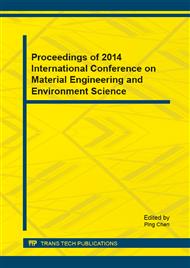[1]
IPCC, The Physical Science Basis. Contribution of Working Group I to the Fourth Assessment Report of the Intergovernmental Panel on Climate Change, Cambridge University Press, Cambridge, United Kingdom and New York, NY, USA, 2007, p.996.
DOI: 10.1080/01944363.2014.954464
Google Scholar
[2]
A.B. Farooq, A.H. Khan, Climate Change Perspective in Pakistan. Proc. Capacity Building APN Workshop on Global Change Research, Islamabad, 2004, p.39–46.
Google Scholar
[3]
Z.Z. Hu, S. Yang, R. Wu, Long-term climate variations in China and global warming signals. J. Geophys. Res., 108 (2003) 4614.
DOI: 10.1029/2003jd003651
Google Scholar
[4]
P. Zhai, X. Pan, Trends in temperature extremes during 1951–1999 in China. Geophys. Res. Lett. 30 (2003) (1913).
DOI: 10.1029/2003gl018004
Google Scholar
[5]
D. Duhan, A. Pandey, Statiscal analysis of long term spatial and temporal trends of precipitation during 1901-2002 at Madhya Pradesh, India, Atmospheric Research 122 (2013) 136-149.
DOI: 10.1016/j.atmosres.2012.10.010
Google Scholar
[6]
B.J. Peterson, R.M. Holmes, J.W. McClelland, C.J. Vorosmarty, R.B. Lammers, I.A. Shiklomanov, A.I. Shiklomanov, S. Rahmstorf, Increasing river discharge to the Arctic Ocean. Science, 298 (2002) 137–143.
DOI: 10.1126/science.1077445
Google Scholar
[7]
Y.F. Shi, Y.P. Shen, R.J. Hu, Preliminary study on signal, impact and foreground of climatic shift from warm-dry to warm-humid in Northwest China. J. Glaciol. Geocryol. 24 (2002) 219–226.
Google Scholar
[8]
R.H. Rimi, S.H. Rahman, S. Karmakar, S.G. Hussain, Trend analysis of climate change and investigation on its probable impacts on rice production at Satkhira, Bangladesh, 6 (2014) 37-50.
Google Scholar
[9]
S.S.A. Shah, S. Nisa, A. Khan, Z. Rahman, S.M.A. Shah, Trends and variability in climate parameters of Peshawar district, Sci., Tech. and Dev., 31 (2012) 341-347.
Google Scholar
[10]
A. Imran, Q. Zaman, M. Afzal, Temporal Trends in the Peak Monsoonal Precipitation Events over Northeast Pakistan, Pakistan Journal of Meteorology, 10 (2013): 19-30.
Google Scholar
[11]
S.B. Cheema, M. Hanif, Seasonal precipitation variation over Punjab province, Pakistan Journal of Meteorology, 10 (2013): 61-82.
Google Scholar
[12]
H. Hartmann, H. Buchanan, Trends in Extreme Precipitation Events in the Indus River Basin and Flooding in Pakistan, Atmosphere-Ocean, 52 (2014) 77-91.
DOI: 10.1080/07055900.2013.859124
Google Scholar
[13]
S. Yue, P. Pilon, B. Phinney, G. Cavadias, The influence of autocorrelation on the ability to detect trend in hydrological series, Hydrol. Process, 16 (2002) 1807–1829.
DOI: 10.1002/hyp.1095
Google Scholar
[14]
M. Shadmani, S. Marofi, M. Roknian, Trend analysis in reference evapotranspiration using Mann-Kendall and Spearman's rho tests in arid regions of Iran, Water Resour Manage, 26 (2012) 211-224.
DOI: 10.1007/s11269-011-9913-z
Google Scholar
[15]
G.C. Blain, The Mann-Kendall test: the need to consider the interaction between serial correlation and trend, Agricultural Engineering, 35 (2013).
DOI: 10.4025/actasciagron.v35i4.16006
Google Scholar
[16]
M. Yaseen, T. Rientjes, G. Nabi, H. Rehman, M. Latif, Assessment of recent temperature trends in Mangla watershed, Journal of Himalayan Earth Sciences Volume, 47 (2014) 107-121.
Google Scholar
[17]
H.B. Mann, Nonparametric tests against trend, Econometrica, 13 (1945) 245-259.
DOI: 10.2307/1907187
Google Scholar
[18]
M.G. Kendall, Rank correlation methods. Griffin, London, (1975).
Google Scholar
[19]
E.L. Lehmann, Nonparametrics, Statistical Methods Based on Ranks. Holden-Day, Inc, California, (1975).
Google Scholar
[20]
R. Sneyers, On the statistical analysis of series of observations, World Meteorological Organization, Technical Note no. 143, WMO (1990) no. 415.
Google Scholar
[21]
P.K. Sen, Estimates of the regression coefficient based on Kendall's tau, J. Am. Statist. Assoc. 63 (1968) 1379-1389.
Google Scholar


